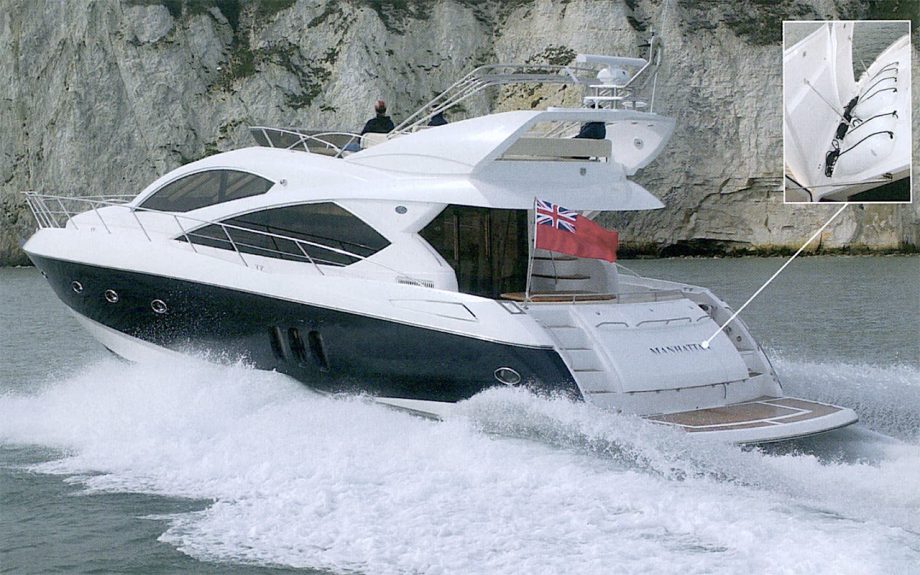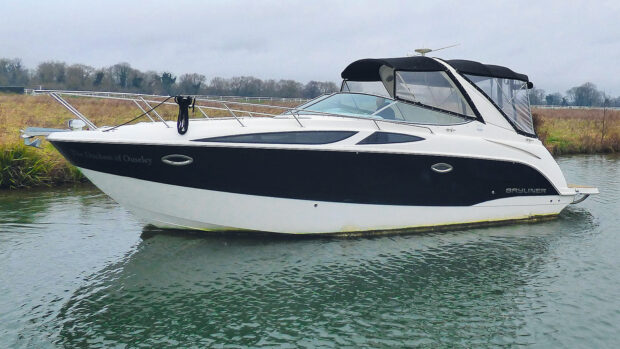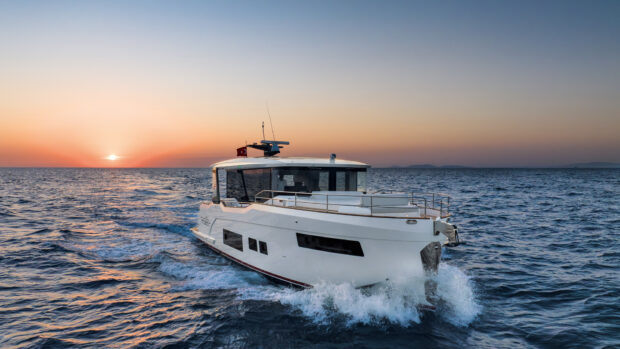Who says that vast acres of accommodation mean sedate handling? Not Sunseeker, whose Manhattan 60 boats boast a huge saloon, yet hasn’t lost the sporting instincts of its ancestors. We test a British bulldog that has the heart of a whippet.
Space, they say, is the ultimate luxury and nowhere is that more evident than on board a boat.
Even a flybridge cruiser of 50ft or more can feel cramped when compared to a luxury apartment.
That’s where Sunseeker’s designers did so well with the original Manhattan 50.
It always felt bigger than the name suggested, and now its latest sibling, the Sunseeker Manhattan 60, is aiming to repeat the trick.
At over £1.1 million, every square inch of it needs to count.
First impressions of the Sunseeker Manhattan 60
Externally, the Sunseeker Manhattan 60 may have inherited the generic style of its smaller sibling, but this is not the area most likely to grab your attention.
For that you have to step inside the saloon. It does not seem plausible that a 60-footer can sport a two-tier saloon that feels so large and so light inside.
Even taking into account the 60’s true overall length of 64ft 4in (19.60m), most of the similar length flybridge boats of yesteryear feel a whole order of magnitude smaller inside.
How have Sunseeker‘s designers pulled this off? You would figure this out the first time you drove the Sunseeker Manhattan 60 from inside.
Gaze in front and you’d swear that you were driving a 50-footer at most, so short is the foredeck.
What Sunseeker have become adept at is shuffling the front of their superstructures further and further forward, while at the same time retaining sleek looks outside.

Side door improves ventilation as well as movement around the boat.
The result is extra space inside the saloon that is very real, not illusory. Two other things push the 60 even further in the same direction.
Sunseeker have resisted the temptation to cram the saloon full of furniture in favour of wider walkways and open spaces.
Consequently, there’s always room for people to pass, a real bonus on a busy boat.
Secondly, elongating the superstructure has allowed Sunseeker to enlarge the window area, so much so that in the lower part of the saloon adjacent to the seating, the single large panes of glass either side have become superyacht sized.
They even beat the big oblong windows you find on large trawler yachts because the 60’s are not split into smaller sections.

The galley may be downstairs in a less sociable postion, but the payback is this amazingly spacious, light-filled saloon.
With that unobstructed layout and those immense windows, the effect of all that extra space is considerable – the 60’s saloon is so full of light and so roomy that you will question Sunseeker’s claims about the size of the boat.
I’ve yet to find another similar-sized flybridge boat that has attained quite the same result. This sense of room to spare continues down below.
The four doors that lead into the full-beam owner’s suite and the front end of the accommodation (comprising the other two ensuite cabins and the day heads) open off a pair of minilobbies at the ends of the galley, areas too roomy to be considered mere corridors.
Throughout the boat, headroom and berth sizes were all fine- notwithstanding the 60’s two low points of 5ft 10in (1.77m) alongside the owner’s double berth and between the two berths in the guest cabin, you won’t generally find your toupee dislodged unless you exceed 6ft 5in (1.96m) in your deckics.
Fit and finish
Several details stood out. All the wardrobes arc lined with cedar – this keeps these areas smelling fresh and I’m told it leeches a natural anti-bacterial agent that gives moths a hard time.
Sunseeker still fit fiddles inside their lockers and on their countertops, a sound practical touch. And Sunseeker sensibly use positive push-push locks on their lockers and drawers.
Despite their decline on an increasing number of boats, surely they should remain an essential safety feature on anything designed to hurtle over lumpy seas at 30 knots.

Sunseeker still fit positive push-push catches on their locker doors – an essential safety feature on a fast boat.
If you have ever spent time on your hands and knees, scrabbling around a gyrating saloon while picking up shards of broken glass, not to mention a three-tier drawer full of glass and crockery, you will understand how I feel.
Putting aside any purely subjective likes or dislikes, it was difficult to find obvious fault with anything.
Build quality was extremely good and very consistent, and I could not find any suspect areas behind the scenes, however deeply I dug by removing drawers and locker lids and inspection panels, all the way back to the glassfibre hull shell.
The fit and finish on all the 60’s joinery was as impressive as any I’ve seen, and the shutlines running between the adjoining timber and fabric panels were all uniformly tight and even.
Is there any area that could be improved?
Well, the plain grey painted lockers comprising the subsidiary storage areas under the berths and the saloon seats are nowhere as slick as the 60’s primary storage areas inside lockers and drawers.
The ultimate refinement would be to have a behind-the-scenes finish the equal or the visible joinery, which a few boats achieve, or perhaps lockers with smoothly moulded fibreglass internals, which are kinder on their contents and easier to wipe clean.
Accommodation aboard the Sunseeker Manhattan 60
This saloon offers more than just light and space – it works very well, too.
Both sets of seats are deep and comfortable, with the two crescent-shaped examples near the helm able to cope easily with three plus two of the most corpulent adults, or four plus three more slender forms.
The lower U-shaped area is large enough for a relaxed seven or a slightly cosier eight, perhaps sat watching the TV, which is normally hidden behind the large bottle and tumbler cabinet opposite.
When grub’s up, this boat is one of the few that could easily cope with its full complement of six at mealtimes, plus two guests.
VVith the table unfolded and one couple sat on stools, eight adults could dine in style, with space enough for proper place settings.

Big portholes as usual – the middle port opens so that crew can more easily clean the outside pair without launching the tender.
The table may not be height adjustable as some are, but unlike many fixed tables it’s set low enough to be comfortable for kids as well as grown ups.
Altogether, it’s an exceptionally well thought out, comfortable and practical dinette and searing area.
Cooking should pose no problems, with the roomy galley providing plenty of countertop and storage space, although it would be better still if the single sink was positioned along the main run of countertop, not tucked into the corner where it is a more awkward stretch to use.
The galley’s position at cabin level presents a straightforward trade to consider.
Providing such an unobstructed, spacious and seat-rich saloon on the Sunseeker Manhattan 60 is only possible with the galley downstairs.

The alternative, as on Sunseeker’s Manhattan 66 and some of the 60’s rivals, is to site the galley up at saloon level – a more sociable place for the chef at mealtimes, or simply for making a cup of tea.
And without the 60’s seven steps to climb to the saloon, galley-up arrangements are more convenient for the deck areas too, which often need supplying with food and drink mon: regularly than the formal dinette.
The rest of the accommodation works equally well. All three cabins sport ensuite heads, with the biggest reserved for the owner.
As expected, the owner’s full-beam cabin is brimming with storage, and the guests do reasonably well too. Self-closing drawers throughout the boat lend a decadent touch.
Driving the Sunseeker Manhattan 60
In a word, sporty. Even if you have been lucky enough to experience the latest generation of big British flybridge boats with their amazingly fluid and fast-acting handling, the Sunseeker Manhattan 60 will still surprise you.
It is remarkable just how quickly and precisely a 31-tonne, 64ft 4 in-long (19.60m) boat can be made to turn and steer, and in terms of outright manoeuvrability the 60 is as fleet as they come.
Don’t think that this translates into wayward behaviour, though.
With its big rudders, plus its deep propeller tunnels creating a sort of mini-keel along the aftermost 25% or so of the hull, the 60 tracks in a dead straight line if you take your hands off the wheel, with or without the autopilot.
Pushed to its limits, during lock-to-lock gyrations at full speed, the sporty 60 heels a few degrees more than some of its rivals – in no way alarming, but just enough to have us temporarily holding onto our seats on the flybridge.
With the largest 900hp MAN diesels we recorded a two-way average of 29.9 knots, running in a metre swell with a light chop on top kicked up by the gentle Force 2.
Sunseeker also sell this boat with the 775hp Volvo D12-800 engines – extrapolating from our test figures suggests around 28 knots with this option.
If you are tempted by the modest £36,400 saving these engines present, bear in mind that it was a cool day and we had a clean hull bottom with only 50% fuel and water and four crew, and no stores on board.
The D12-800s are impressive engines, but I feel it might be asking too much of them to effortlessly haul a voluminous 60-footer around in the intense heat of the Mediterranean with a dirty bottom, full tanks and a boatload of stores.
Down below, the driver’s lot is fine, with an expansive and clearly laid out dash leaving plenty of space for all manner of navigation gear, plus niceties such as a 12V socket and a tinny holder, a tray for odds and ends, and other ledges to corral loose gear such as mobile phones.
Compared with some, the four reassuringly large mullions feel a little intrusive when you’re scanning left and right for traffic, but the line of sight out over the bow is fine, even for shorties.
Up top, the clash and the sightlines are fine, but the ergonomics are lacking. With a fixed wheel and its unmoveable bench seal, Sunseeker’s boat lacks the useful adjustment often provided on other British boats.
And because the dash is set relatively low, you have to stoop to reach the throttles when you stand up (as most of us instinctively do to moor). Lastly, it’s easy to catch your knees on the moulding when you’re sitting down to drive.
On deck
As below decks, there is oodles of comfy seating, on the flybridge and in the cockpit, all served by practical hi-lo tables. Overall, the rest of the deck is well designed and thought out.
My only significant lament is that, when it comes to the stern fairlead design, Sunseeker have not mimicked the practical multi-angle fairlead arrangement they use on their Manhattan 66, or utilised rollers as some boats do.

As inside, there’s acres of seating in the cockpit and on the flybridge.
Instead they have fitted rudimentary stainless plates, which will probably chafe mooring ropes left idle for long periods.
The lack of a separate lazarette would normally have made it into the ‘thumbs down’ list, but the Sunseeker Manhattan 60 offers so much to counterbalance this.
Tenders can be stowed on the standard-issue hi-Io bathing platform. Fender tails live in natty dedicated wells sited immediately behind the cleats, and there’s a roomy locker under the stairs. Sunseeker have engineered a large fender and warps locker across the transom.
Crew cabin access (through a large door off the bathing platform) is for superior to the usual under-seat hatch in the cockpit, and it’s likely that this cabin will be used as an alternate lazarette on many 60s.
Engineering and construction
During our tour of their 37M at the London Boat Show, Sunseeker reckoned that the experience of building their flagship to the rigours of the MCA large Yacht Code and RINA commercial compliance is bound to filter down into their smaller boats in the future.

Everything in the 60’s engineroom appeared expertly installed.
Even as it stands though, everything in the 60’s engineroom appeared expertly installed – the impression was that a single person had fitted it out so as to avoid any conflicts between piping, machinery, exhaust runs and cabling, leaving everything as unencumbered as
possible.
The result is a practical and accessible installation, and as an owner the only upgrade I’d insist upon is fitting dual fuel filters with clear bowls, and changeover valves to allow for visual checks and a speedy switchover in the event of a blockage.
This is because both engines draw from a single central tank, so dirty fuel could conceivably disrupt both filters simultaneously.
Verdict
Whatever personal yardsticks you use for weighing up a boat – handling and performance say, or accommodation, build and engineering quality, or the question of style – two things on the Sunseeker Manhattan 60 stand out most of all. Firstly, the sporty handling.
The current generation of big British flybridge boats are amazing to drive – fluid, precise and sporty in a way that hardly seems possible.
Continuing this tradition is the Sunseeker Manhattan 60, as impressively sporty as anything you can find, with steering to be marvelled at.
On a cruising boat, this sporty handling is a treat you may only allow yourself occasionally, but the saloon – the 60’s second outstanding feature – is something you’ll be using every moment you’re on board.
It feels improbably roomy, yet it’s also very practical. It sports one of the best dinette arrangements you’ll find, and the huge rear windows mean a wonderful sense of connection with the world outside.
But it does leave you with a trade to ponder. Some rivals site the galley in the saloon.
Naturally, this gobbles up space, and often impairs the clear sightlines though the saloon, but the upside is greater sociability and convenience for those using the galley.
The Sunseeker Manhattan 60 does have a few other minor pros and cons to consider, but the superb saloon versus the galley down is probably the one you’ll want to contemplate the most.
Before you decide, I recommend you wander into the 6O’s saloon on a bright sunny day. It is hard to imagine somebody buying a boat just because of the impact it has when they first step inside. But if there is a big flybridge boat that might do the trick, this is the one.
First published in the July 2007 issue of MBY.
Pros
- Workings of saloon
- Sporty handling
- Overall build quality
- Hi-lo bathing platform
- Outstanding dinette/seating
- Engineering installation
- Lazarette/crew cabin access
Cons
- Flybridge helm ergonomics
- Stern fairlead desig
Details
Price from: £1.09 million inc UK VAT (twin 775hp Volvo)
Price tested: £1.12 million inc UK VAT (twin 900hp MAN)
Overall length: 64ft 4in 19.60m)
Hull length: 57ft 7in (17.55m) MBY estimate ex platform
Waterline length: 48ft 2in (14.64m)
Beam: 16ft Sin (5.00m)
Displacement: 31 tonnes halt load, (3.2 tonnes of fuel & water in total)
Draught: 4ft 11in (1.49m)
Fuel capacity: 660 imp gal (3,000 litres)
Water capacity: 154 imp gal (700 litres)
Cruising: 23.0 knots, 243 miles @ 1,950rpm
Flat out: 29.9 knots, 210 miles @ 2,330rpm
RCD category: B for 12 people
Designers: Don Shead & Sunseeker
Contact: Sunseeker London
Tel: +44 (0)20 7493 3441
Website: www.sunseekerboats.co.uk
Sunseeker Sales Group: +44 (0)1202 666060
Website: www.sunseeker.com










